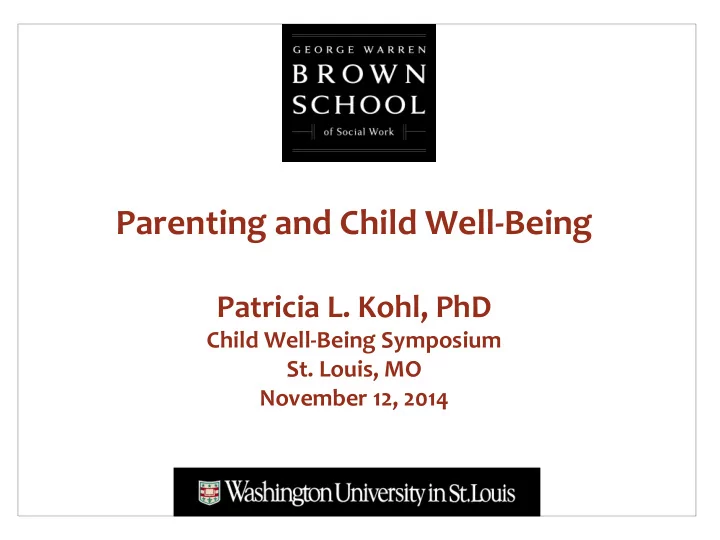

Parenting and Child Well-Being Patricia L. Kohl, PhD Child Well-Being Symposium St. Louis, MO November 12, 2014
Children are said to exhibit well-being if all of the following are met: • They successfully attain all relevant and appropriate developmental milestones. • They display capacities that we know are associated with future success. These capacities are both internal to the child (such as resiliency) and external to the child (such as a secure attachment). • They are able to relate to themselves, their peers, and to the world around them as children. This definition was informed by the work of R. Raghavan and developed by the St. Louis Child Well-Being Symposium steering committee
Ecology of Child Development Microsystem: Families, friends, (Brofenbrenner) neighbors, health care, child care, school Macrosystem Mesosystem: Interactions Exosystem between the different structures Mesosystem in the microsystem Exosystem: Microsystem Social context, conditions in community, access to and quality of services Macrosystem: Social norms and values, policies, economic conditions
Determinants of Child Well-Being • Ecological perspective purports that a child’s well - being is affected by a variety of multi-level factors – Neighborhood – School – Family • Children do better when raised in safe, nurturing environment
PARENTING AS SOCIAL DETERMINANT OF CHILD WELL-BEING
Maternal Depression and Parenting • Depressed mothers express more anger and irritability toward their children than non-depressed mothers 1 • Depression impacts how mothers monitor, discipline, and engage their children throughout the development process 2,3 • Maternal depression associated with increased neglectful parenting and increased emotionally abusive parenting* *Kohl, P. L., Kagotho, J. N., & Dixon, D. (2011). Parenting behaviors among depressed mothers in the child welfare system. Social Work Research, 35, 215-225 .
Intimate Partner Violence and Parenting Behaviors Maternal Self Reported Parenting Behaviors IPV No IPV Total Harsh parenting 13.6% 9.6% 10.7% Neglectful parenting*** 66.2 30.0 40.2 Emotional abuse*** 73.9 49.3 56.2 Kohl, P. L. (2010, September). Intimate partner violence among child neglect cases: Met and unmet service needs. Paper presented at the annual meeting of the Translational Research on Child Neglect Consortium.
Parenting Behaviors Associated with Child Behavior Problems 4-7 • Parental negativity • Harshness • Use of coercion • Use/overuse of physical punishment • Inconsistent parenting
Mediating Role of Parenting Behaviors Parenting Behaviors Parent Child Well-Being Characteristics Hence, need interventions to (1) improve parental mental health, safety and functioning, and (2) to promote positive, assertive parenting behaviors to affect child well-being.
Interventions to Promote Child Well-Being and Strengthen Families (and Prevent Child Maltreatment) • Family & Individual Levels – Home visiting – Parent training – Quality early childhood education
Pathways Triple P Trial (in brief) • Families whose case is opened to child protective services following a maltreatment investigation in the metro-St. Louis region • Child is between ages of 3 and 11 • Target child remained in home following the investigation • Sample size = 144 • Randomly assigned to two conditions: Pathways or treatment as usual • Triangulated data: parent, teacher and child report
Sample • Caregivers in the sample were characterized by – Economic insecurity – Depression – Intimate Partner Violence – Substance abuse – High rates of employment • YET… still achieved very favorable outcomes
Kohl et al. ( in preparation )
Investment in quality, effective interventions can result in better outcomes for children and families!
FATHER INVOLVEMENT AND CHILD WELL-BEING
Father-Child Relationships and Child Well-Being • Father involvement in their children’s lives has been linked to children’s cognitive, social and emotional development • Among children of African American fathers living in urban environments, those who experience positive father-child relationships have been shown to have fewer behavior problems, and to be less likely to engage in risky or antisocial behaviors than those who experience negative father-child relationships 8
• Qualitative interviews with 36 urban African American fathers learned that – Fathers expressed conventional views of their fathering roles as provider – Also embraced their role as nurturer and teacher – They placed the most emphasis on ‘being there’ for their children
Triple P and Fathers • Evidence of effectiveness of Triple P with multiple, diverse populations • Less is known about effectiveness with fathers – As with other parenting interventions, more mothers than fathers participate in Triple P 9,10 • Even less is known about with African American fathers – Race of fathers often not reported – With other interventions, when race is reported most father participants are white
Parents’ and Children’s Pre and Posttest Means (SDs) and t-test Statistics Domain Pretest Posttest Difference Effect Size σ M(SD) M(SD) M(SD) t d p Parent Behaviors Corporal Punishment 4.97(1.99) 4.50(1.70) -0.63(1.78) 0.35 -2.43 47 .01 Inconsistent Discipline 13.97(4.35) 12.22(3.57) -1.45(3.76) 0.38 -2.68 47 .01 Involvement 36.94(6.97) 37.47(6.51) 1.50(6.2) 0.24 1.68 47 .10 Poor Monitoring 13.14(3.64) 12.95(3.71) 0.18(2.92) 0.06 0.44 47 .65 Positive Parenting 26.16(3.56) 25.56(3.43) -0.20(3.83) 0.05 -0.38 47 .70 Parental Stress Child Behavior 27.36(7.74) 26.55(8.60) -0.65(7.19) 0.09 -0.63 46 .53 Parenting Competence 26.62(7.40) 24.81(6.99) -1.82(6.79) 0.26 -1.84 46 .07 Parent-Child Dysfunctional Interaction 22.26(6.64) 21.61(6.21) -0.06(5.08) 0.01 -0.09 46 .93 Child Behaviors Frequency of Disruptive Behaviors 96.32(35.04) 85.41(30.36) -9.77(33.13) 0.29 -2.04 47 .04 Parent Perception of Behaviors as Problematic 9.07(8.22) 7.68(8.09) -1.08(1.13) 0.95 -1.05 47 .29 70% Completed the Triple P intervention and posttest ( n= 48)
Conclusion • Fathers and their children can benefit from participation in Triple P • Triple P is robust • The service needs of urban African American fathers are likely very different from this majority population – despite the differences, Triple P likely fits well with this population
Acknowledgements • Funding – Centers for Disease Control and Prevention, National Center for Injury Prevention and Control (1U01 CF001627-03). – National Institute for Child Health and Human Development (1R01HD061454-04) – National Institute for Mental Health (R03MH082203) – Implementation Research Institute (IRI) through an award from the National Institute of Mental Health (R25 MH080916-01A2) and the Department of Veterans Affairs, Health Services Research & Development Service, Quality Enhancement Research Initiative (QUERI
Recommend
More recommend